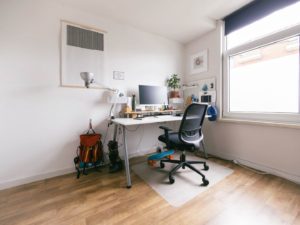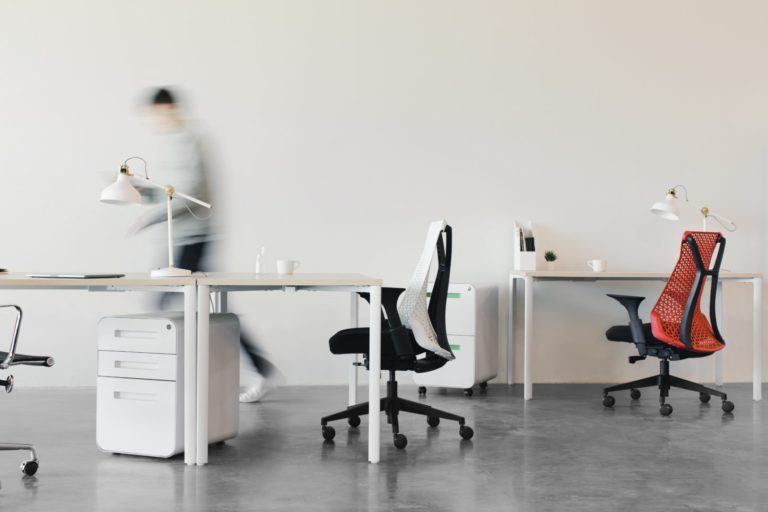Chair ergonomics is something you are quite possibly experiencing at this very moment while you read this article. I thought it would be appropriate to be kick off our education series with this topic. Industrial design is a broad subject with many areas of expertise within it.
We’ll be diving into different products and discussing their ergonomics from both a user and a design perspective. While the mechanical engineering isn’t heavy in a product like this, industrial design does a ton of work.
A lot goes into design when it comes to products that interact with the body, especially for long periods of time. Here we’re going to talk about chair ergonomics, specifically office/work chairs.
Choosing an ergonomic chair doesn’t really cross the mind until the pain of sitting in an uncomfortable chair starts to weigh upon your work, health, and sometimes your overall happiness. What does it mean when someone says “ergonomic”.
We almost all know the word, and know that it has something to do about a product being comfy or nor hurting. Ergonomics is the science of fitting the task to the worker to maximize productivity while reducing discomfort, fatigue and injury. You can of course replace the word worker with user and sometimes remove productivity depending on the product.
Discomfort will affect your work (or fun) and it’s a good designers job to make sure discomfort isn’t a part of a product or process. Ergonomic chairs are designed to suit a range of people; however, there is no guarantee that they will suit any one person in particular.
For example, a chair could be too high and the arm rests too far apart for a short, slim person, but fit an average height and size person just fine. In addition, chairs may not suit every task or arrangement at the workstation, or it might not even be for a workstation. A chair becomes ergonomic only when it specifically suits a worker’s size.
BLANK
Ian Peterman, CEO Tweet

Specific Design Points

Adjustability – Check to see that seat height is adjustable.
Seat height range – Check whether the seat height can be adjusted to the height recommended for the worker who will use it. Other chairs may have to be selected for very short or tall workers.
Backrest – Check to see that the backrest is adjustable both vertically and in the frontward and backward direction and has a firm lumbar support.
Seat depth – Select the seats that suit the tallest and the shortest users.
Stability – Check for the stability of the chair; a five-point base is recommended.
General Design Ideas
BLANK
Ian Peterman, CEO Tweet
- One chair does not fit everyone. The user’s body dimensions must be used when selecting a chair so that it does not strain one part of the body while fitting another
- Collect data about the user’s body height. The optimal seat height is about one quarter of the body height. This is only a rule of thumb since the torso-to-leg ratio can vary widely
- There is no chair suitable for every activity. For example, dentists require a different chair than do industrial workers or computer operators
- Consider maintenance and repair costs. Check with the manufacturer for items to inspect for and how often inspection should be done

Chair Selection and Fitting

While selecting a chair, keep your chest open and relax the shoulders while making chair adjustments. Thighs are parallel to the ground and both feet are placed directly and securely on the floor, not dangling on the foot ring.
BLANK
Ian Peterman, CEO Tweet
When designing a work chair, several basic concepts should be considered:
- Height off the ground
- Armrests or not
- Curve of the backrest
- Adjustments for a wide range of body types
- Adjustable back-seat mechanism for supporting the spine
- Material choices
- Wheels or not
- Range of seat motion – does it lean back, turn 360°, etc.
Ergonomics play a huge factor in our comfort level and selecting the chair we work in 8+ hours a day correctly is very important as a user. Chair ergonomics play a role in the comfort and health of workers around the world. As designers, when we design a work chair, we have two options. The first is to take in the wide diversity of humans and find ways to accommodate as many shapes and sizes as possible to allow the product to help as many people as possible.
BLANK
Ian Peterman, CEO Tweet

The second is to select a very narrow group of people and create a perfect chair for them. Ergonomics is its own science, not just a cool word we use (though it does sound cool), and we’ll be discussing it more through this series. We hope you’ll learn a bit about what we do and how we do it.
Your Next Steps
Related Conscious Design BLOG Posts
What’s a Feasibility Study?
A feasibility study is a very important step in making sure a product will be successful. I break down what they are and why they matter.
What it Takes to Develop a Smart Product
As the Internet of Things has grown over the years, smart products have become a pretty hot item. Many people have product ideas for turning a “dumb” product into a “smart” one. It’s great, I love that we are improving our tools and gadgets in so many new and interesting ways. Technology is something that amazes me, and will probably continue to do so for the rest of my life. For a lot of people, it might seem like a fairly simple task to just add some electronics to a product and make it smart. You should understand what you or your business will need to developing such a product. You might have gotten an idea about what it really takes in our post a couple weeks ago Time, Budgets, & Luxury, but I’d like to dive more into exactly what it takes to create a smart product. There is a lot of time and effort that is beyond what low-tech products need to become a reality. For us, “smart” is anything that contains electronics that can connect to other electronics, so wi-fi, Bluetooth, NFC, USB, etc, usually there are sensors or other input points that collect data to be shared with other devices. Putting a motor into a mower doesn’t make it “smart”. Putting a computer on board with internet access, connected to an app would make it “smart”. A “smart” product doesn’t always have to touch the internet either, there are many closed circuit smart devices. IOT (internet of things) products MUST touch the internet however. In no particular order, here is a breakdown of everything that goes into developing a “smart” product. This will give you an idea of what you can expect if you choose to dive into this process. Disciplines required Most “dumb” products can get away with just an Industrial Designer or Mechanical Engineer. Both work, but you can read more about the differences in our post3 Things You Should Know About Designers & Engineers. No electronics means no coders, no electrical engineers, and many others. If you are working with basic electronics, such as motors, switches, etc, you can sometimes avoid getting an electronics person involved. BLANK Ian Peterman, CEO Tweet There are many mechanical side people who can make that happen. Now, if we’re creating a “smart” product, we will need these: App Design & Development Electronics Design Electrical Manufacturing Web Design & Development There are possibly a few others depending on how big you go, such as database development, but these areas would cover most of the work needed to get the project done. Time It can easily double the amount of time to design and develop a new product by adding in electronics that would make a product “smart”. Does this mean it would take longer on a calendar? Not necessarily. When we can, we prefer to do side-by-side development of the mechanical and electrical. This ensures both sides work together and keeps the timeline shorter. The collaboration between mechanical and electrical can really build some synergy with the project. The result is that issues can be caught earlier, avoiding them from popping up super late in the process where it’s harder and more expensive to fix. Cost BLANK Ian Peterman, CEO Tweet Double the time, at least double the cost. Electronics are usually more expensive to prototype. The benefit is the manufacturing on the back end makes super components, even fully custom ones. These products also sell for a higher premium than their “dumb” counter parts. Planning Working on more complex projects such as this involves a lot more planning and project management. Here at the Peterman Design Firm, that is one of our core competencies. You need to make sure the firm you work with has experienced Project Managers on its team. They also need to be able to handle the load required to bring such a product to life. BLANK Ian Peterman, CEO Tweet Network We’ve talked about how important your network is in our last post Building Your Network for Success. This is a place where it really matters as you need so many resources to get the project completed. If you are working with some of the very large and expensive firms out there, they probably have such a large in-house team they can handle most things, but you pay for it. Medium sized firms often still have the network and don’t do everything in-house. Small ones and freelancers don’t always have the network you need and are often still building them. The caveat of course is if they have been in business for 20 plus years, they probably have a good network. Feasibility Study BLANK Ian Peterman, CEO Tweet I put this here just because people like to skim, and this is a key part. Feasibility studies should never be skipped with products in this category. A feasibility study is very important to do at the beginning of your project. The firm you choose to use should be able to offer this service by itself. Don’t commit to full development until you know it can be done. A complete feasibility study from the Peterman Design Firm will give you cost expectations for the entire project, time frame, potential issues, project duration estimation and breakdown, and some market information on competitors. If you’d like to learn more about feasibility studies, check out our post What’s a Feasibility Study? When you have a great idea for a “smart” product, it’s at least worth getting a consultation on the idea. If your budget can handle it, a feasibility study would be valuable. Then if it looks good, invest the money. The great thing with “smart” products is that they are in high demand. Plus we seem to be on an exponential growth with them. For now, it’s a trend I feel will stay with us for a while, if not permanently. Your Next Steps Developing Smart Products What does it take to develop a smart product?
5 Tips for Market Research & Analysis
Wondering about Market Research & Analysis? This will give you a few tips on what it is and how to start your own research.


